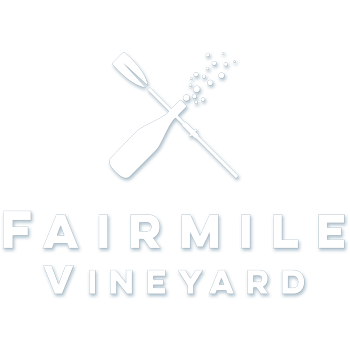
Sustainability
Since co-owner Jan has long been a member of the Institute of Sustainability and Environmental Professionals (formerly IEMA), Fairmile Vineyard's mission is to produce great English wines – sustainably and with respect for the environment. The vineyard nestles in the foothills of the Chilterns National Landscape (formerly AONB) and the owners are keen to enhance the land for the enjoyment of future generations.
To this end we made the decision to retain all the existing mature trees, including a couple of beautiful cedars even though it would mean that many vines would be shaded for part of the day - and deprived of water. Some of the trees have been used to house small bird, owl and bat boxes to attract further wildlife. The Fairmile (avenue) supports a large population of bats - who stop nocturnal insects eating too many ripe grapes! A windbreak of 350 Italian Alder trees, grown and sourced from a UK nursery, was planted along the western boundary. Our lime trees are a magnet for honey bees, which produce a delicious green honey that doesn't crystallise over time.
We started the vineyard by bringing 3 hectares (7½ acres) of previously fallow land into productive use. The first job was to plough the land, then plant a crop of winter mustard to fix nitrogen naturally from the atmosphere. The soil was further improved with compost from green kitchen bin council waste collections. From Day 1 of planting, we have never irrigated our vines, preferring to let nature do the work.
Vines are not particularly "hungry" plants, and our 3 hectares only need one tonne of mineral fertiliser pellets every three years (following a soil analysis which accurately matches fertiliser to the soil's needs).
Whilst some vineyards remove grass from between the rows, allowing the exposed stones/flints to reflect accumulated heat back onto the vines, we leave as many natural grasses and wildflowers as possible to create wildlife corridors and encourage biodiversity. It is, however, important to keep the area immediately beneath the vines free from weeds and grass that could otherwise harbour diseases or compete for nutrients. We therefore use a novel type of mower (with cutters on hydraulic arms) which mows right up to the edges of, and even in between, individual vines. This reduces the need for weeding (which can disturb the soil, exposing beneficial organisms to unwanted ultraviolet light). The mower is also unusually mounted in front of the tractor, which cuts the grass before it is trampled by the wheels, so reducing the amount of mowing - and tractor fuel - required.
Our vine leaves act as a carbon "sink", absorbing around 20 tonnes of CO2 annually from the atmosphere (not including our tree canopies) which, together with pruned canes, mulch back into the soil - and are never burned.
Pigeons are notorious vineyard raiders in late summer but our only bird-scarers are the red kites and buzzards usually seen circling overhead. Whilst red kites are not known to directly attack pigeons, the presence of these large birds of prey seems to have a deterrent effect! Pigeons are further discouraged from loitering, being unable to roost on the 45°-angle branches of our Alder windbreak.
Our picking crates are reused every harvest time, and product packaging - glass, natural cork, wire cages (that hold the corks in place), cardboard boxes - can be reused or recycled. Any plastic containers we receive go to Agri.cycle. We now upcycle empty wine bottles into scented candles - a white and rosé, of course!
Unusually for a vineyard, we lie within walking distance of a town centre, and many of our visitors walk or cycle to reach us, including from Henley train station or from the town's fabulous hotels/B&B/campsites.
